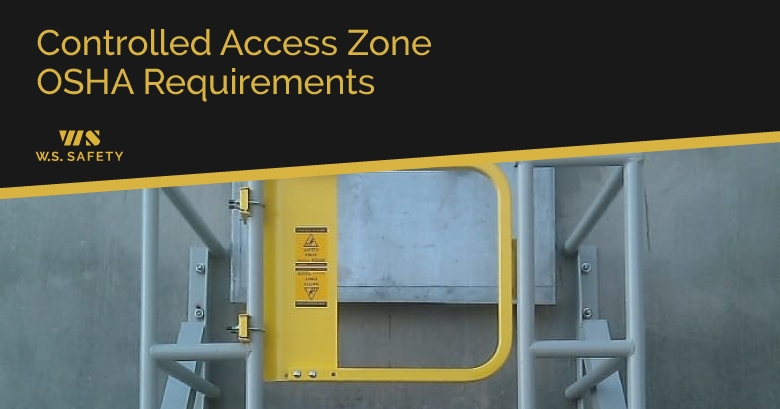A controlled access zone is a safety measure for workers at heights where guardrails or fall arrest equipment are not able to be used. OSHA requires employers to implement fall protection measures for employees working at heights of six feet or more. A controlled access zone is used to prevent non-essential workers or personnel from entering a particular area of the job site. Let’s take a look at what controlled access zones are, and how they should be implemented in compliance with OSHA regulations.
What is a controlled access zone?
OSHA’s definition of a controlled access zone is “an area in which certain work may take place without the use of guardrail systems, personal fall arrest systems, or safety net systems, and access to the zone is controlled.”
A controlled access zone is an area of a jobsite that is only accessible to some workers. Workers who are not approved to be in that area are prohibited from entering, with any exceptions to the rule depending on the worksite’s unique fall protection plan. A safety monitor must be present to monitor the area and the people going in and out and to ensure that proper safety precautions are being followed.
One type of controlled access zone would be a guardrail system that has a gate. The guardrail is used to cordon off the area and block non-essential workers from entering. A safety monitor supervises the area and controls who is allowed through the gate.
A controlled access zone is most typically used for jobs requiring workers to be on a leading edge. Examples of this might include some types of masonry and bricklaying. In overhand bricklaying, for example, the leading edge shifts as the job progresses and there is often nowhere to install an anchorpoint. Because of the increased degree of danger posed to workers, a controlled access zone is only used as a last resort on very specific types of job sites.
Controlled Access Zone Checklist
OSHA safety requirements for controlled access zones include:
- Defining the area clearly and ensure that appropriate signage is posted to prevent unauthorized personnel from entering.
- Ensure that only authorized workers are entering the area
- Each employee working in a controlled access zone must be directed by a competent safety monitor
- Employees working in a controlled access zone must respond quickly to any warnings or promptings by the safety monitor.
- Control lines must be erected at a minimum distance of 6 feet and a maximum distance of 25 feet from the leading edge.
- Control lines must be marked out clearly and made highly visible at intervals of 6 feet or less.
- The lowest point (including sagging) must be at least 39 inches above the working area and no higher than 45 inches.
- Control lines are required to withstand at least 200 pounds of weight
- The safety monitor must be a competent individual who does not have conflicting responsibilities on the job site. A monitor must have a clear line of vision to the workers at all times, and be prepared to quickly identify hazards and warn a worker when a hazard presents itself, or if the worker is acting unsafely.
Controlled access zone vs warning line
By definition, a warning line system is any type of barrier set up on a rooftop that warns workers of an unprotected edge. This also designates a working area that does not require workers to use guardrails, belts or safety net systems.
Warning line systems have a number of regulations that differ slightly from controlled access zones, including:
- Warning line systems are installed around all edges of a roof, whereas a controlled access zone is limited to one specific area of a job site
- The rope, chain or wire used in the warning line system must have a minimum tensile strength of 500 pounds, as opposed to the 300 pounds required for controlled access zones
- Warning line systems are generally erected to protect all workers on a job site, whereas a controlled access zone is used to control which employees have access to specific areas on a job site
Implementing A Controlled Access Zone
1. Identify hazards in work environments
OSHA requires that the following work zones must institute appropriate fall protection measures:
- Work sites where falls of six feet or greater may be possible
- Unprotected edges
- Any area around a hole or opening
- Ramps and walkways
- Excavation sites
- Any area in proximity to potentially dangerous equipment
2. Follow OSHA regulations for controlled access zones
A controlled access zone must be marked clearly using tape, wire, or rope. Employers are expected to adhere to all OSHA requirements (see our checklist above).
3. Develop and implement a site-specific fall protection plan
All employees must be adequately trained and able to identify potential hazards on a job site, as well as know the appropriate protocol to deal with emergencies.
All workers and supervisors in controlled access zones must follow OSHA fall protection requirements. Some work environments may necessitate annual training.
To ensure safety in controlled access zones, it is critical that workers are careful to implement safe practices and keep a watchful eye for potential hazards.
4. Masonry and Bricklaying Regulations
OSHA has some specific rules around controlled access zones and overhand bricklaying.
- Lines marking out the controlled access zone must be set up between 10 and 15 feet from any unprotected edge
- Lines must be set up to create an enclosing perimeter. Workers are not allowed inside the controlled access zone unless they are actively engaged in bricklaying or masonry activities.
Controlled access zones present varying degrees of risk, depending on the surrounding environment and nature of the work. For that reason, it’s especially important for employers and workers to be well-versed in best practices when using a controlled access zone as a fall protection measure.


